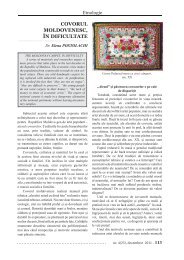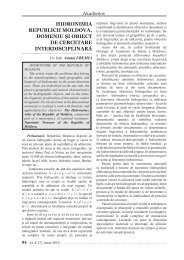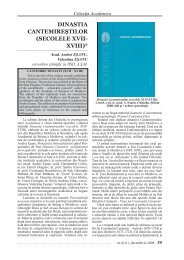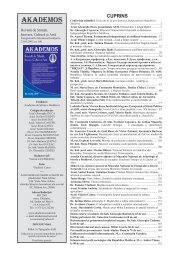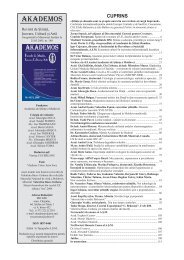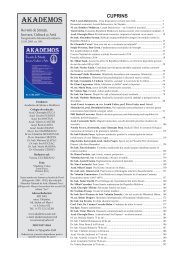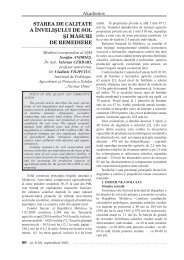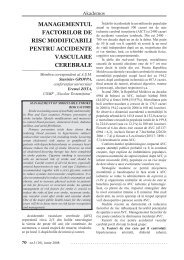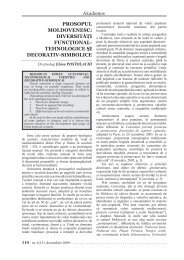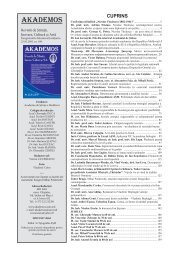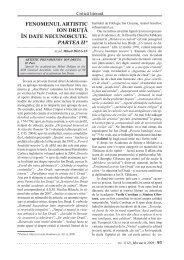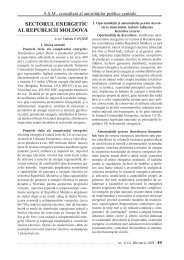Academos 2 2010.indd - Akademos - Academia de ÅtiinÅ£e a Moldovei
Academos 2 2010.indd - Akademos - Academia de ÅtiinÅ£e a Moldovei
Academos 2 2010.indd - Akademos - Academia de ÅtiinÅ£e a Moldovei
Create successful ePaper yourself
Turn your PDF publications into a flip-book with our unique Google optimized e-Paper software.
Ştiinţe agroindustriale<br />
METODE<br />
DE PROGNOZARE<br />
A PRODUCTIVITĂŢII<br />
GRÂULUI DE TOAMNĂ<br />
ŞI MĂSURI DE SPORIRE<br />
A FERTILITĂŢII SOLULUI<br />
M. cor. Serafim ANDRIEŞ,<br />
director general<br />
al Institutului <strong>de</strong> Pedologie, Agrochimie<br />
şi Protecţie a Solului „Nicolae Dimo”<br />
METHODS FOR AUTUMN WHEAT YIELD<br />
PROGNOSIS AND MEASURES FOR INCREASING<br />
SOIL FERTILITY<br />
The present article discusses the methodology of<br />
forecasting the autumn wheat yield in early spring.<br />
The precipitations in the months of September –<br />
March are taken as a basis on whose account the<br />
water reserves in soil <strong>de</strong>termine, to a great extend,<br />
the yield results. The <strong>de</strong>pen<strong>de</strong>nce between autumn<br />
wheat productivity (y, q/ha) and the precipitations in<br />
the months of September – March (x, mm) is joined in<br />
the linear equation of the type: y=a+bx. This method<br />
can be applied when forecasting the yield at the level<br />
of the Republic, district, and agricultural farm.<br />
The second method of forecasting the yield is<br />
based on the estimation of humidity reserves in soil<br />
at the beginning of the spring vegetation phase of<br />
the crops by consi<strong>de</strong>ring the multi-annual average<br />
amount of precipitations in the months of April – June.<br />
This method is applied when forecasting the yield at<br />
the fi eld and crop rotation levels. The <strong>de</strong>viation of the<br />
obtained harvest with the estimated one constitutes,<br />
as a rule, ±15-25%.<br />
It has been established that the intensifi cation<br />
of agriculture and the implementation of advanced<br />
technologies leads to a more rational use of water<br />
reserves in soil that contributes to the formation of<br />
the yield. In the conditions of intensive agriculture<br />
(1971-1994), the autumn wheat consumes 7.3 – 9.4<br />
mm of water in or<strong>de</strong>r to form 1 q of grains. Soil<br />
<strong>de</strong>gradation, non-observance of the crop rotation<br />
system and of the technologies used for crop<br />
cultivation result in the intensifi cation of pedologic<br />
drought, the increase by 1.3 – 2.0 times of the water<br />
consumption for the formation of a production unit,<br />
and the reduction of the harvest by 1.3 – 1.5 times.<br />
In or<strong>de</strong>r to obtain high yields in steppe conditions,<br />
it is necessary to direct the agro-technical, agrochemical<br />
and pedo-ameliorative processes to<br />
soil fertility conservation and rational use of soil<br />
humidity.<br />
Introducere<br />
Teritoriul Republicii Moldova, prin aşezarea<br />
sa geografică, se încadrează în zona cu umiditate<br />
insuficientă şi instabilă. Instabilitatea condiţiilor<br />
agrometeorologice <strong>de</strong>termină în mod esenţial<br />
variabilitatea şi nivelul recoltei plantelor <strong>de</strong> cultură.<br />
Producătorii agricoli, precum şi autorităţile publice,<br />
au nevoie <strong>de</strong> o prognoză a productivităţii culturilor<br />
<strong>de</strong> câmp la <strong>de</strong>sprimăvărare spre a întreprin<strong>de</strong><br />
măsurile respective.<br />
Recolta prognozată înseamnă <strong>de</strong>terminarea<br />
productivităţii plantelor <strong>de</strong> cultură, când o parte<br />
din factorii <strong>de</strong> creştere şi <strong>de</strong> <strong>de</strong>zvoltare nu pot fi<br />
optimizaţi. Prognozarea trebuie să răspundă la<br />
două întrebări esenţiale. Mai întâi, ce nivel <strong>de</strong><br />
recoltă poate fi aşteptat în condiţiile meteorologice<br />
concrete ale fiecărui an agricol. Şi, mai apoi, care<br />
proce<strong>de</strong>e tehnologice (agrotehnice, agrochimice,<br />
pedoameliorative) şi măsuri organizatorice pot fi<br />
aplicate pentru atingerea obiectivului preconizat.<br />
În acest articol prezentăm metodologia prognozării<br />
recoltei grâului <strong>de</strong> toamnă la <strong>de</strong>sprimăvărare şi<br />
complexul <strong>de</strong> măsuri pentru formarea recoltelor<br />
înalte.<br />
Material şi metodă<br />
Pentru elaborarea metodologiei prognozei au<br />
fost analizate date iniţiale privind <strong>de</strong>punerile<br />
atmosferice şi recoltele grâului <strong>de</strong> toamnă pe<br />
parcursul a 47 ani (1962-2008). Datele iniţiale au<br />
fost colectate din Buletinele agrometeorologice ale<br />
Serviciului Hidrometeorologic <strong>de</strong> Stat şi din Anuarele<br />
statistice ale Republicii Moldova, rezultatele fiind<br />
prelucrate prin diferite meto<strong>de</strong> statistice.<br />
Prognoza recoltei s-a efectuat pornind <strong>de</strong> la faptul<br />
că în condiţiile zonei cernoziomice, în care intră<br />
şi teritoriul Republicii Moldova, recolta grâului <strong>de</strong><br />
toamnă este <strong>de</strong>terminată în mare măsură <strong>de</strong> rezervele<br />
<strong>de</strong> apă acumulate în sol la <strong>de</strong>sprimăvărare din contul<br />
<strong>de</strong>punerilor atmosferice în perioada rece a anului<br />
[A.Atamaniuc, 1969; E.Ulanova, 1975; S.Andrieş,<br />
1982]. Însă, dat fiind că termenii optimi <strong>de</strong> însămânţare<br />
a grâului <strong>de</strong> toamnă începe din septembrie, la calcularea<br />
rezervelor <strong>de</strong> apă fusese inclusă şi această lună.<br />
Au fost testate două meto<strong>de</strong> <strong>de</strong> prognozare a<br />
productivităţii grâului <strong>de</strong> toamnă în funcţie <strong>de</strong>:<br />
1) precipitaţiile atmosferice în perioada septembriemartie<br />
(la nivel <strong>de</strong> republică, raion, gospodărie<br />
agricolă) şi 2) rezervele <strong>de</strong> umiditate în sol la<br />
începutul perioa<strong>de</strong>i <strong>de</strong> vegetaţie şi cantitatea <strong>de</strong><br />
precipitaţii productive din lunile aprilie-iunie întrun<br />
ciclu multianual (la nivel <strong>de</strong> câmp, asolament).<br />
Testările metodologiei <strong>de</strong> prognozare a recoltei<br />
grâului <strong>de</strong> toamnă în condiţii <strong>de</strong> producţie la nivel<br />
nr. 2(17), iunie 2010 - 85



